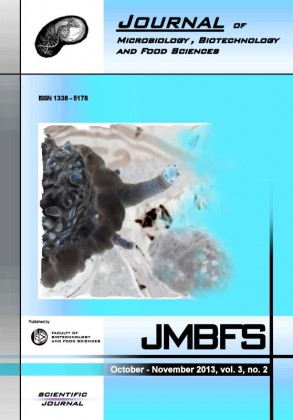INCIDENCE AND SURVIVAL OF LIPOLYTIC ORGANISMS MONITORED FOR TWELVE MONTHS IN DOMESTIC WASTEWATER AND RECEIVING STREAM
Keywords:
Lipolytic organisms, coliform, wastewater, receiving streamAbstract
The incidence and survival of lipolytic organisms in domestic wastewater and receiving stream were monitored over 12 months. The average total bacterial count in the wastewater samples reduced in April and November by 24.2% and 41.6% respectively. There was also a reduction of 42.3% and 60.1% in the load in the receiving stream in August and July. Subsequently, at 5m downstream from the entry of the wastewater the microbial load reduced in March (19.2%) and June (19.2%). However, the occurrence of coliforms was more affected in the months of May (53%) to July (87.2%). At 5m and 10m downstream the coliform population reduced by 27.9% and 30.1% respectively. Of the twelve (12) bacterial isolates obtained at the exit of the wastewater into the receiving stream, only four (4) were found to possess lipolytic activity. These include the species of Enterococcus, Klebsiella, Pseudomonas and Staphylococcus. There was no significant difference in the amount of nutrients found in the domestic wastewater and receiving stream during the months. This paper also discusses the implication of disposing large amounts of wastewater effluents into the receiving water and the need to remedy and minimize the overall impact of such pollution on the environment.Downloads
Download data is not yet available.
Downloads
Published
2013-10-01
How to Cite
Odeyemi, A., & Aderiye, B. (2013). INCIDENCE AND SURVIVAL OF LIPOLYTIC ORGANISMS MONITORED FOR TWELVE MONTHS IN DOMESTIC WASTEWATER AND RECEIVING STREAM. Journal of Microbiology, Biotechnology and Food Sciences, 3(2), 122–126. Retrieved from https://office2.jmbfs.org/index.php/JMBFS/article/view/7054
Issue
Section
Microbiology
License
Copyright (c) 2013 Adebowale Odeyemi, Babatunde Aderiye

This work is licensed under a Creative Commons Attribution 4.0 International License.
All papers published in the Journal of Microbiology, Biotechnology and Food Sciences are published under a CC-BY licence (CC-BY 4.0). Published materials can be shared (copy and redistribute the material in any medium or format) and adapted (remix, transform, and build upon the material for any purpose, even commercially) with specifying the author(s).

